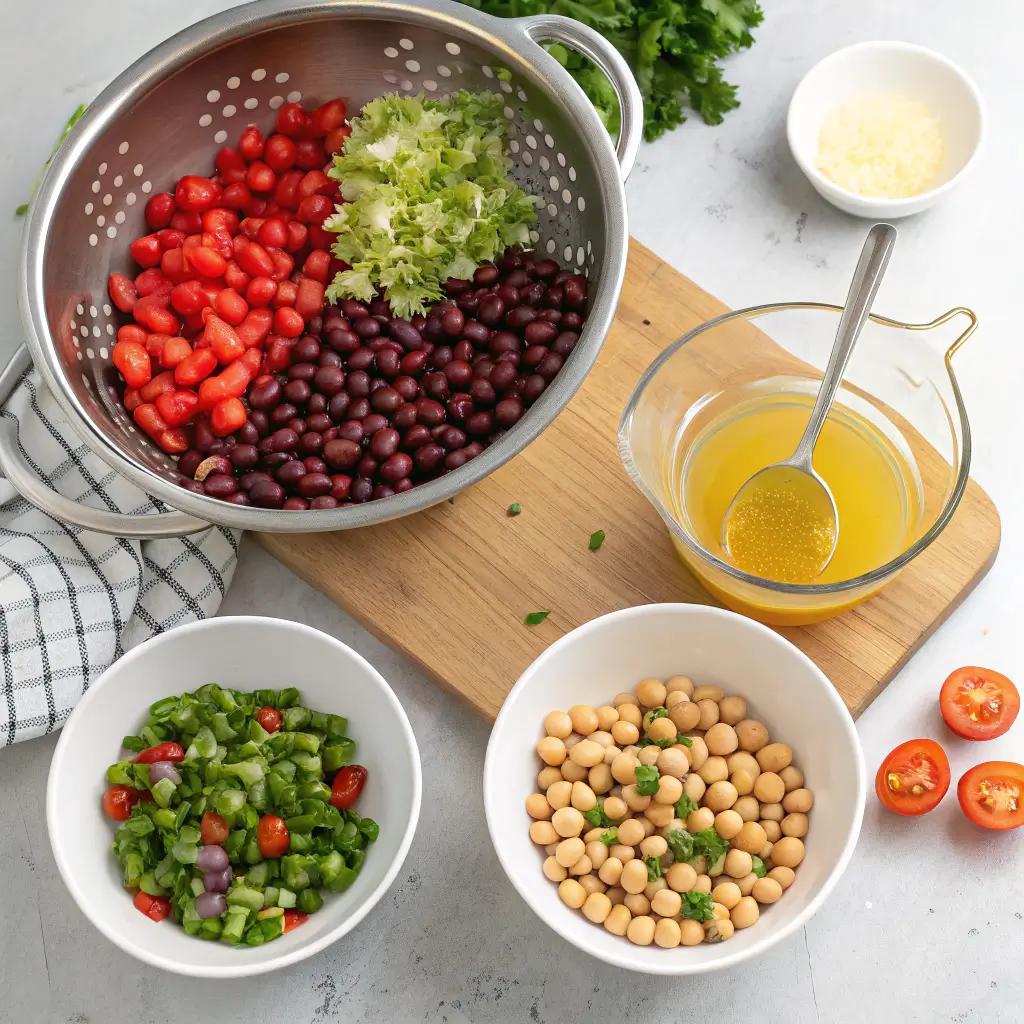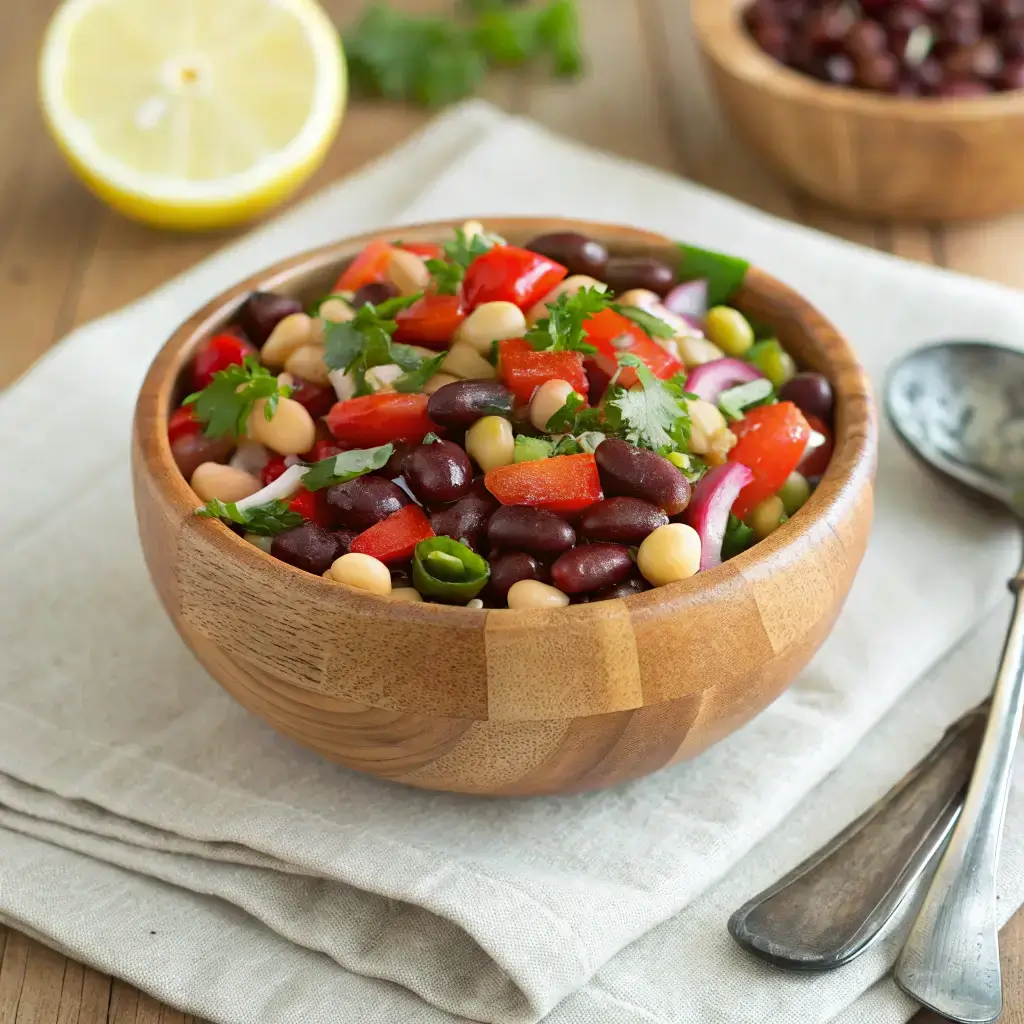Looking for a salad that actually fills you up and keeps you satisfied for hours? A dense bean salad does exactly that—and more. Packed with protein, fiber, texture, and bold flavor, this kind of salad goes beyond lettuce and light toppings. It’s hearty, nutritious, and versatile enough to serve as a side or a full-on main dish.
In this guide, you’ll learn how to make the best dense bean salad from scratch. We’ll walk through which beans work best, how to build layers of texture and flavor, what ingredients boost nutrition without sacrificing taste, and how to store it for meal prep. Whether you’re eating plant-based, prepping lunches, or need a crowd-pleasing potluck idea, this bean salad delivers big time.
Let’s begin by exploring why dense bean salads have become a go-to for healthy, filling meals that never get boring.

Table of Contents
Table of Contents
What Makes a Dense Bean Salad So Satisfying?
The word “dense” in dense bean salad isn’t just about how heavy it feels in a bowl. It’s about the experience of every bite—rich in texture, loaded with plant protein, and full of satisfying, whole-food ingredients that leave you feeling nourished, not empty. Unlike a flimsy side salad, a dense bean salad is made to stand on its own.
Beans are naturally rich in complex carbohydrates, fiber, and essential minerals like magnesium and potassium. When you mix several types—like kidney beans, black beans, and chickpeas—you get a powerful combination of flavors, textures, and nutrition. It’s one of the few salads that can act as a full meal and actually keep you full.
What separates a top-tier dense bean salad from a basic mix is how it’s built. A good one includes a balance of textures—soft and creamy beans with crunchy vegetables like bell peppers or red onion. Add in fresh herbs like parsley or cilantro, and a tangy dressing made with lemon juice or red wine vinegar, and suddenly you’ve turned a bowl of legumes into something fresh, bright, and layered.
Dense bean salads are also ideal for meal prep because they taste even better after sitting in the fridge. The flavors have time to meld, and the beans absorb the dressing for an even richer taste. They’re portable, easy to portion, and work great for lunchboxes, office meals, or light dinners on busy nights.
But perhaps the biggest reason people love a dense bean salad is because it’s deeply satisfying without being heavy or greasy. You get all the protein and fiber you need in one bowl, without meat or processed ingredients. It fuels your body, keeps digestion smooth, and tastes amazing cold or at room temperature.
So if you’re tired of salads that feel more like appetizers than meals, it’s time to rethink your bowl. A dense bean salad isn’t just another recipe—it’s a foundation for endless flavor, function, and filling nutrition.
Your Guide to the Best Beans for a Filling Bean Salad
Every great dense bean salad starts with one essential ingredient: the right mix of beans. The choices you make here directly affect the texture, flavor, color, and overall satisfaction level of your salad. Beans are the foundation—they provide bulk, plant-based protein, and fiber—so choosing well matters more than you might think.
The key to building the perfect base is variety. Using more than one type of bean not only adds complexity to the taste but also makes the salad look more vibrant and appealing. Kidney beans, with their deep red color and slightly firm bite, pair beautifully with creamy cannellini beans or tender black beans. On the other hand, dried beans—though more time-consuming—give you total control over texture and seasoning. Soaking and simmering them until just tender allows you to build flavor from the start.
Don’t forget about color and visual appeal. A well-balanced dense bean salad isn’t just tasty—it looks inviting too. Combining beans with different hues (like black beans, chickpeas, and red kidney beans) turns a simple salad into a dish that pops off the plate. And that matters, especially when you’re serving guests or prepping food for social gatherings.
One last tip: aim for beans that hold their shape. Overcooked or overly soft beans can fall apart during mixing and ruin the structure of your salad. Go for al dente when in doubt—you can always let the flavors blend in the fridge, but you can’t undo mushy texture once it’s there.
Choosing the right beans is step one in mastering the best dense bean salad recipe. Once you’ve got the perfect combo, the rest of the dish builds effortlessly around it.

Prepping the Beans for Maximum Flavor and Texture
Once you’ve chosen your beans, the next step in crafting the perfect dense bean salad is prepping them properly. Even high-quality beans can fall flat if they’re not treated with a bit of care before they hit the bowl. The way you prep your beans directly affects the final taste, mouthfeel, and overall success of your salad.
Another key step is seasoning the beans before adding anything else. A small drizzle of olive oil, a pinch of salt, or a splash of lemon juice can enhance their natural flavor and create a better base for the final dish. Doing this while they’re still slightly warm allows the flavors to soak in deeper.
By taking time to prep your beans the right way, you’re setting the foundation for flavor-packed results.
The Building Blocks of a Top-Ranked Dense Bean Salad
Once your beans are ready, the next step in creating the ultimate dense bean salad is building a balanced mix of textures, flavors, and nutrients around them. This isn’t just about tossing a few ingredients into a bowl—it’s about assembling a salad that’s bold, satisfying, and impossible to forget.
Next comes the flavor foundation: herbs and spices.Chopped parsley gives it a clean, green finish; cilantro adds brightness and a slightly citrusy edge; basil adds a hint of sweetness. These herbs do more than garnish—they breathe life into every bite. As for spices, a dash of cumin or smoked paprika can lend a warm, earthy undertone that elevates the beans without overpowering them.
The dressing is where it all ties together. A dense bean salad needs a bold, well-balanced dressing that can stand up to the beans without drowning them. Olive oil forms the rich, silky base, while acid—like lemon juice or red wine vinegar—cuts through the starchiness of the beans and brightens everything up. A touch of Dijon mustard or a bit of minced garlic can add depth and sharpness.
Healthy fats also play a big role in both flavor and satiety. Chopped avocado brings creaminess and richness without the need for mayo or dairy. If you want crunch and healthy oils, toss in toasted sunflower seeds, pumpkin seeds, or chopped walnuts. These additions enhance both the texture and the nutritional profile, helping you stay full longer.
When done right, a dense bean salad isn’t just dense in calories—it’s dense in value. You get protein, fiber, heart-healthy fats, and a wide range of micronutrients—all in one satisfying dish. And because it’s made with whole, minimally processed ingredients, your body recognizes and uses every bite.
So don’t rush this part. The beans are the foundation, but every add-in counts. Build it with intention, and what you’ll end up with is more than just a salad—it’s a fully balanced meal you’ll want to make again and again.
Step-by-Step Recipe: The Perfect Dense Bean Salad
Now that we’ve covered the structure and prep, let’s bring it all together with a full, foolproof recipe. This dense bean salad recipe is built for flavor, texture, and maximum satisfaction. It’s simple enough for a weekday lunch yet impressive enough to serve at gatherings. The balance of ingredients ensures each bite delivers protein-packed goodness with plenty of freshness and crunch.
Start by prepping your beans. If you’re using canned beans, rinse and drain three types—chickpeas, red kidney beans, and black beans work beautifully together. Use about one cup of each. If you cooked your beans from dried, make sure they’re fully chilled and firm before adding them to the mix.
Now it’s time to build flavor with fresh herbs. Add a handful of chopped parsley and a tablespoon of fresh dill or cilantro, depending on your taste. These herbs give the salad brightness and a garden-fresh quality that keeps it from tasting too heavy.
What makes this the best dense bean salad recipe isn’t just the ingredients—it’s the balance. Each component plays a role in creating a dish that’s dense in nutrition and flavor, without ever feeling too heavy. The dressing complements the beans without overpowering them, while the herbs and raw veggies give it freshness in every bite.
Customization Ideas to Fit Any Diet or Occasion
If you’re following a Mediterranean-style eating pattern, this salad fits right in. Toss in kalamata olives, diced cucumber, and crumbled feta for a Mediterranean dense bean salad that’s salty, bright, and refreshing. A squeeze of lemon and a pinch of oregano in the dressing brings all the flavors together, transforming a simple bean mix into a vibrant mezze-inspired dish.
For high-protein or heartier versions, consider adding grains like quinoa, farro, or bulgur. These grains are mild in flavor but contribute extra bulk and staying power to your salad. Just be sure to cool the grains before adding them so they don’t break down the beans or turn the salad soggy. These versions are perfect for make-ahead lunches, post-workout meals, or meatless dinner bowls.
Dense bean salads are perfect for entertaining too. They hold up well on buffet tables, can be made ahead, and don’t need to be served piping hot. You can double or triple the batch, customize portions for picky eaters, and even split the bowl into two flavor profiles for variety.
Best Ways to Serve and Store Dense Bean Salad
A well-made dense bean salad is more than just a one-time dish—it’s a flexible, make-ahead meal that works across a variety of situations. Whether you’re serving it fresh from the fridge, packing it for lunch, or prepping for a big event, knowing how to serve and store it correctly makes a big difference in flavor and texture.
Start with how you serve it. Dense bean salad tastes best slightly chilled or at room temperature. Right after mixing, let it rest for 20 to 30 minutes so the flavors can fully develop. This rest time allows the beans to soak up the dressing and helps the raw vegetables release just enough moisture to blend into the mix. If you’re hosting guests, transfer the salad to a shallow serving dish or a large wooden bowl—this gives it a rustic, fresh presentation that’s easy to dress up with a sprinkle of herbs or a drizzle of oil.
It also works great as part of a larger meal spread. Serve your dense bean salad alongside grilled chicken, fish, or roasted vegetables. It also makes a perfect base layer in salad bowls, where you can add leafy greens, grains, and even a poached egg or grilled tofu for a nutrient-packed meal.
When it comes to storage, this salad truly shines. Store it in an airtight container in the refrigerator, and it will stay fresh for up to five days. In fact, many people find it tastes even better on day two or three. As the beans sit, they continue to absorb the dressing and deepen in flavor, making leftovers just as satisfying as the first serving.
If you’re meal prepping, portion the dense bean salad into smaller containers for quick grab-and-go lunches. It travels well, doesn’t require reheating, and stays delicious even after hours in the fridge. It’s perfect for busy weekdays or when you need something ready without effort.
Avoid freezing the salad, though. The texture of beans and fresh vegetables doesn’t hold up well to freezing and thawing, and your salad will likely turn mushy. If you need to prep components ahead of time, cook and freeze your beans separately, then combine with fresh ingredients when ready to serve.
The key to enjoying dense bean salad all week long is to keep it chilled, sealed, and handled with care. With proper storage and thoughtful presentation, it remains one of the most convenient and satisfying dishes in your recipe lineup.
visit our page facebook
Common Mistakes to Avoid with Bean Salads
Even though making a dense bean salad seems simple on the surface, a few small missteps can turn a great idea into a bland or soggy disappointment. If you’ve ever had a bean salad that tasted flat, fell apart, or left you underwhelmed, chances are one of these common mistakes was to blame.
One of the most frequent problems is overmixing. Beans are naturally tender, especially after cooking or rinsing from a can. When you mix them too aggressively, especially with soft vegetables or creamy add-ins like avocado, they break down quickly and turn your salad into mush. Always fold gently using a wide spatula or spoon, and stir just enough to combine without crushing your ingredients.
Too much liquid is another issue that can ruin the texture of your dense bean salad. This can happen when vegetables like cucumbers or tomatoes are added without being patted dry, or when beans are too wet from rinsing. Moisture from high-water veggies or improperly drained beans dilutes the dressing and leaves your salad soupy instead of dense. To avoid this, blot your ingredients dry before mixing and go light on watery additions unless you’re serving it immediately.
Another mistake? Not letting the salad rest. Rushing to serve it right after mixing doesn’t give the flavors time to blend or the dressing to coat the beans properly. Letting your dense bean salad sit for at least 20–30 minutes before serving gives it that next-level flavor and cohesion. For even better results, refrigerate it for a few hours and serve later—it gets better with time.
Lastly, be mindful of ingredient balance. A dense bean salad should be hearty, not heavy. Adding too many beans without enough contrast—like fresh herbs, crunchy veggies, or citrus—can make the dish feel monotonous. Likewise, an overload of creamy or oily ingredients can weigh the salad down. Keep proportions balanced so each bite offers variety and freshness.
Avoiding these common pitfalls ensures your salad delivers on flavor, texture, and satisfaction every single time. With just a little attention to prep and detail, your dense bean salad can go from average to absolutely top-tier.
Delicious Variations of Dense Bean Salad to Try
Once you’ve mastered the base recipe, there’s no limit to how you can spin it—flavor profiles, cultural influences, and seasonal ingredients all give you the opportunity to make each version unique, while still maintaining that satisfying density and fiber-rich punch.
Looking for something creamy and cooling?Use chickpeas, white beans, and cannellini beans as the base. Add chopped cucumber, cherry tomatoes, and lots of fresh parsley and dill. Toss it in a dressing made from tahini, lemon juice, garlic, and olive oil. The result is creamy, herbaceous, and filling—without a drop of dairy.
For a lighter, citrus-forward version, try a spring or summer salad with lentils, edamame, and chickpeas. Add diced orange segments, chopped mint, and thinly sliced radishes. A citrus vinaigrette made with orange juice, lemon zest, and honey keeps the flavor clean and bright, while still packing protein and fiber into every spoonful. It’s refreshing, colorful, and perfect for warm weather.
Want something with Asian flair? Mix chickpeas with shelled edamame and red beans. Add shredded cabbage, scallions, and grated carrots. Then toss it in a sesame-ginger dressing made with rice vinegar, toasted sesame oil, soy sauce, and fresh ginger.
You don’t need to follow a strict recipe every time. Just choose your beans, add some texture, brighten it up with herbs or citrus, and balance it with a bold dressing. From spicy to sweet, creamy to crunchy, there’s always a new combination waiting to be discovered—and each one brings something different to the table.










1 thought on “Perfect Dense Bean Salad How to Make a top 1 recipe”